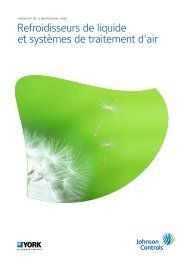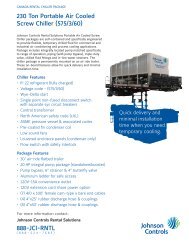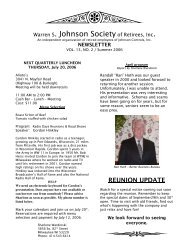Rxf - Johnson Controls Inc.
Rxf - Johnson Controls Inc.
Rxf - Johnson Controls Inc.
Create successful ePaper yourself
Turn your PDF publications into a flip-book with our unique Google optimized e-Paper software.
DEMAND PUMP ASSEMBLY<br />
Assembly Notes On Standard Mechanical Seal (Synthetic<br />
Rubber Bellows Type)<br />
NOTE: Read carefully before reassembling pump<br />
The seal used in this pump is simple to install and good<br />
performance will result if care is taken during installation.<br />
The principle of a mechanical seal is contact between the<br />
rotary and stationary members. These parts are lapped to<br />
a high finish and their sealing effectiveness depends on<br />
complete contact.<br />
Prior to installing the rotary portion of the mechanical seal,<br />
prepare and organize the rotor shaft, head and idler assemblies,<br />
and appropriate gaskets for quick assembly<br />
Once the rotary portion of the mechanical seal is installed on<br />
the rotor shaft, it is necessary to assemble parts as quickly<br />
as possible to ensure that the seal does not stick to the shaft<br />
in the wrong axial position. The seal will stick to the shaft<br />
after several minutes setting time.<br />
Never touch sealing faces with anything except clean hands<br />
or clean cloth. Minute particles can scratch the seal faces<br />
and cause leakage.<br />
1. Coat the idler pin with refrigeration oil and place idler<br />
and bushing on idler pin in the head. If replacing a carbongraphite<br />
bushing, refer to "Installation of Carbon Graphite<br />
Bushings".<br />
2. Clean rotor hub and casing seal housing bore. Make sure<br />
both are free from dirt and grit. Coat outer diameter of seal<br />
seat and inner diameter of seal housing bore with refrigeration<br />
oil.<br />
3. Start seal seat in seal housing bore. If force is necessary,<br />
protect seal face with a clean cardboard disc and gently tap it<br />
in place with a piece of wood. Be sure seal seat is completely<br />
seated in the bore.<br />
4. Place tapered installation sleeve on shaft. Refer to Figure<br />
31. Sleeve is furnished with GG, AS, AK, and AL replacement<br />
mechanical seals. Coat rotor shaft, tapered installation sleeve,<br />
and inner diameter of mechanical seal rotary mem ber with<br />
a generous amount of refrigeration oil. Petrolatum may be<br />
used but grease is not recommended.<br />
5. Place seal spring on the shaft against the rotor hub. Refer<br />
to Figure 32.<br />
6. Slide rotary member, with lapped contact surface facing<br />
away from the spring, over installation sleeve on shaft until<br />
RXF ROTARY SCREW COMPRESSOR UNITS<br />
MAINTENANCE<br />
Figure 31 Figure 32<br />
070.410-IOM (JUL 11)<br />
Page 27<br />
just con tacting the spring. Do not compress the spring. Remove<br />
the installa tion sleeve.<br />
7. Coat the rotor shaft with refrigeration oil. Install the rotor<br />
and shaft into the casing, slowly pushing until the ends of<br />
the rotor teeth are just below the face of the casing. Take<br />
care not to damage the seal seat.<br />
8. Leave the rotor in this position. Withdrawal of rotor and<br />
shaft may displace the carbon seal rotating face and result<br />
in damage to the seal.<br />
9. Place O-ring gasket on the head and install head and idler<br />
assembly on pump. Pump head and casing were marked<br />
before disassembly to ensure proper reassembly. If not, be<br />
sure the idler pin, which is offset in pump head, is positioned<br />
up and equal distance between port connections to allow for<br />
proper flow of liquid through the pump.<br />
10. Tighten the head capscrews evenly.<br />
11. If the pump was equipped with a relief valve and was<br />
removed during disassembly, install on the head with new<br />
O-Rings or gaskets. The relief valve adjusting screw cap must<br />
always point towards the suction port.<br />
12. In 2005, the use of single seal bearings were phased out.<br />
Pumps now use “Sealed for Life” bearings that have seals<br />
on both sides. The new bearings can be installed either side<br />
first and do not need to be packed with grease. For older<br />
models with single seal bearings, pack the inner ball bearing<br />
with multi-purpose grease, NLGI #2.<br />
GG, HJ, HL: Drive the bearing into the bore. Tap the inner<br />
race with a brass bar and lead hammer to position bearing.<br />
Install the inner snap ring.<br />
AS, AK, AL: Install the bearing retainer washer over the shaft<br />
before installing the ball bearing. Install the ball bearing in<br />
the casing with sealed side towards head end of the pump.<br />
Drive the bearing into the bore. Tap the inner race with a<br />
brass bar and lead hammer to position the bearing.<br />
13. GG, HJ, HL: Install the shaft snap ring in groove in the<br />
shaft. See Figure 29.<br />
AS, AK, AL: Install the bearing spacer over the shaft and<br />
against the single row ball bearing. See Figure 30.<br />
14. Pack the lubrication chamber between the inner ball<br />
bearing and double row ball bearing in the thrust bearing assembly<br />
approximately one-half full of multi-purpose grease,<br />
NLGI #2. The thrust bearing assembly will take the remaining<br />
space. See Figures 29 and 30.










![[PDF] Intelligent Fire Annunciator IFA-1000 - Johnson Controls Inc.](https://img.yumpu.com/7424420/1/190x245/pdf-intelligent-fire-annunciator-ifa-1000-johnson-controls-inc.jpg?quality=85)





